Catherine de Medici
Catherine de Medici was one of the most powerful women in Europe for a considerable amount of time during the 16th Century, serving as Queen of France and Regent for three Kings of France. She was born on April 13, 1519, in Florence, Italy. She was a member of the powerful Medici family. Her father was Lorenzo, the ruler of Florence; her mother was Madeleine de La Tour d'Auvergne. Both parents died just a few weeks after Catherine was born, and she grew up being looked after by cousin Giulio de Medici, the new ruler of Florence, and by Alfonsina Orsini, her father's mother. Giulio became Pope Clement VII and, when Catherine was 11, invited her to go to Rome. She lived a handful of convents there, and historians think that she might have had access to the contents of the Vatican Library. An intelligent and curious child and teen, she had a lifelong long passion for science, literature, and the arts. 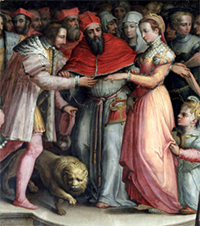
When she was 14, she found herself betrothed to Henry, Duke of Orleans. Henry's father was at the time the French king, Francis I, cousin to Catherine's mother. They were married on Oct. 28, 1533. Henry's older brother was the heir to the throne. Three years later, in 1536, that brother, Francis, died, and Henry became next in line to be king. When the king died, in March 31, 1547, Henry became king. The new monarch embarked on a handful of reforms but also continued his father's quest to defeat Charles V, the Holy Roman Emperor. The quest turned into a lifelong obsession that ended, still unachieved, with Henry's death in 1559. In the 26 years that Catherine and Henry had been married, they had 10 children together. Three of them–Francis, Charles, and Henry–went on to rule the realm, all with their mother as regent. Francis II, was first, succeeding his father on the throne. The young king, married to Mary, Queen of Scots the year before, was 15 in 1559 when he took the throne. 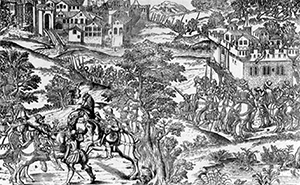
One thing that the young king really liked doing was hunting. He liked taking his new wife with him, and so they went on several hunts together. While they were thus occupied, Catherine and the Guise family were running the government, with François running the army and Cardinal Charles taking care of financial and political matters. This didn't sit well with a number of people in France, particularly the Huguenots, who had been victims of persecution by Henry's father. Francis had chosen to maintain those policies, and the Huguenots had had enough. On March 17, 1560, a large group of people, Huguenots among them, stormed the royal cháteau at Amboise; royal security had no trouble stopping the attack, and the king later ordered the leaders of the attack executed. Rather than keep the peace, these executions served to inflame the populace, and riots proliferated in various cities, notably Lyon and Provence. King Francis sent royal troops to disperse the rioters. Francis had struggled with poor health for his entire life. He took a turn for the severely worse in November 1560, suffering fainting spells. He never recovered and died on December 5. He had no children, and so his younger brother Charles, then only 10, became King Charles IX. 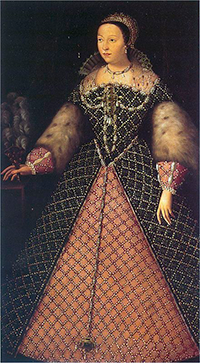
Catherine, as she had done with Francis, was regent. In fact, even when Charles had come of age, she had a hand in all relevant actions of government. The conflict between Catholics and Huguenots, French Calvinists, worsened during Charles's reign. A 1561 religious conference known as the Colloquy of Poissy came to no real reconciliation. Catherine was a Catholic but wanted to keep the peace more than prosecute a religious vendetta. She had the government issue the Edict of Saint-Germain, in January 1562, granting some demands made by Huguenots. The response from the powerful Catholic Guise family, who had been the power behind Francis's throne, was to order a wholesale killing of Huguenots in Wassy on March 1. This came to be known as the Massacre of Wassy. Unsurprisingly, Huguenots took up arms against the government in response. Fighting raged across the realm for a number of months. Leaders on both sides, including Francis, the Duke of Guise, were killed. Catherine again stepped in, organizing a truce in March of 1563. The peace held, and Charles and his mother embarked on a tour of the realm. 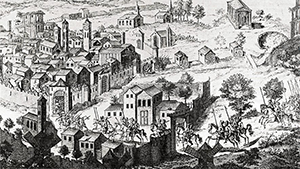
Religious violence flared up in 1567. A number of Huguenots tried to capture the king and members of his family at Meaux. This plot, too, was foiled. Angry Huguenots in Nîmes killed Catholics on the Christian holiday of Michaelmas, an incident that came to be known as Michelade. More battles followed, and the king in 1568 declared another peace. Catholic militants unhappy with the terms of that peace resumed the fighting, and the war dragged on, this time involving forces from England, Navarre, Spain, and Tuscany. The king married in 1570, to Elisabeth of Austria; they had a daughter, Marie Elisabeth of Valois. In that same year came the Peace of Saint-Germain-en-Laye, after which Charles increasingly took advice from Admiral Gaspar de Coligny, a Huguenot leader. 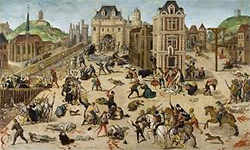
An effort at peace involved the marriage of the king's sister Margaret to Henry of Navarre. A week after the wedding, in August 1572, the Duke of Guise killed Coligny. The violence that followed last five days. Catholics by the thousands targeted Huguenots by the thousands, in what came to be called the St. Bartholomew's Day massacre (right). Estimates of the dead range widely, from a few thousand to tens of thousands. Charles had suffered from ill health his entire life. He is thought to have contracted tuberculosis and by early 1574 was in very bad shape. He died on May 30; his younger brother, Henry, had been elected King of Poland and so couldn't return right away. Catherine remained as regent. Henry did return eventually and was crowned King Henry III. Despite his status as the fourth son (or perhaps because of it), Henry was the favorite son of his mother. She made no compunction about showering him with kind words and kind deeds, long after he was old enough to make his own decisions. The Wars of Religion dragged on, with no end in sight. Neither side was willing to endorse a truce or compromise unless it meant complete happiness for that particular side. On May 12, 1588, a Catholic force under the leadership of the Duke of Guise marched into Paris, in what came to be called the Day of the Barricades. Henry fled the city. A few months later, on December 23, Henry invited the Duke of Guise to a meeting at the Château de Blois. Also invited was the duke's brother, Louis II, Cardinal of Guise. Unbeknownst to either brother, they had walked into a trap. Henry's men killed both brothers and also imprisoned the duke's son. 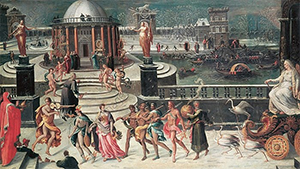
Catherine had maintained a high profile, touring the country on behalf of her son, trying to keep the peace in any way that she could. She also had embraced the ideals of the Renaissance, then flowering across Europe. She supported and patronized various artists, including the painter Antoine Caron (who created Triumph of Winter, left) and had an extensive private collection. She also had a special interest in architecture and had a hand in a few large building projects. She became ill while dancing during the wedding of one of her granddaughters. She died on Jan. 5, 1589 in Blois; she was 69.
|
|
Social Studies for Kids
copyright 2002–2026
David White




